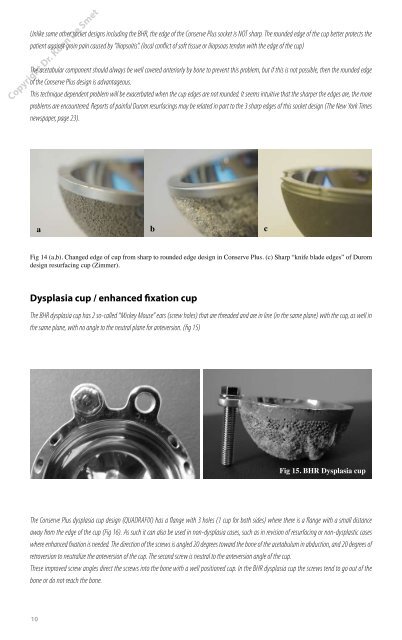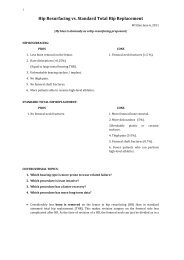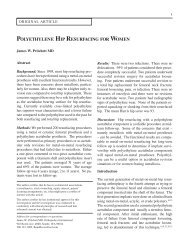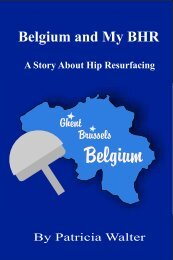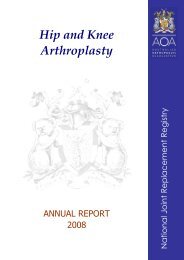Birmingham H ip Resurfacing v ersus C onserv e Plus M etal-on-M ...
Birmingham H ip Resurfacing v ersus C onserv e Plus M etal-on-M ...
Birmingham H ip Resurfacing v ersus C onserv e Plus M etal-on-M ...
Create successful ePaper yourself
Turn your PDF publications into a flip-book with our unique Google optimized e-Paper software.
Unlike some other socket designs including the BHR, the edge of the C<str<strong>on</strong>g><strong>on</strong>serv</str<strong>on</strong>g>e <str<strong>on</strong>g>Plus</str<strong>on</strong>g> socket is NOT sharp. The rounded edge of the cup better protects the<br />
patient against groin pain caused by “iliopsoitis”. (local c<strong>on</strong>flict of soft tissue or iliopsoas tend<strong>on</strong> with the edge of the cup)<br />
The acetabular comp<strong>on</strong>ent should always be well covered anteriorly by b<strong>on</strong>e to prevent this problem, but if this is not possible, then the rounded edge<br />
of the C<str<strong>on</strong>g><strong>on</strong>serv</str<strong>on</strong>g>e <str<strong>on</strong>g>Plus</str<strong>on</strong>g> design is advantageous.<br />
This technique dependent problem will be exacerbated when the cup edges are not rounded. It seems intuitive that the sharper the edges are, the more<br />
problems are encountered. Reports of painful Durom resurfacings may be related in part to the 3 sharp edges of this socket design (The New York Times<br />
newspaper, page 23).<br />
Copyright Dr. Koen De Smet<br />
Dysplasia cup / enhanced fixati<strong>on</strong> cup<br />
The BHR dysplasia cup has 2 so-called “Mickey Mouse” ears (screw holes) that are threaded and are in line (in the same plane) with the cup, as well in<br />
the same plane, with no angle to the neutral plane for anteversi<strong>on</strong>. (fig 15)<br />
The C<str<strong>on</strong>g><strong>on</strong>serv</str<strong>on</strong>g>e <str<strong>on</strong>g>Plus</str<strong>on</strong>g> dysplasia cup design (QUADRAFIX) has a flange with 3 holes (1 cup for both sides) where there is a flange with a small distance<br />
away from the edge of the cup (Fig 16). As such it can also be used in n<strong>on</strong>-dysplasia cases, such as in revisi<strong>on</strong> of resurfacing or n<strong>on</strong>-dysplastic cases<br />
where enhanced fixati<strong>on</strong> is needed. The directi<strong>on</strong> of the screws is angled 20 degrees toward the b<strong>on</strong>e of the acetabulum in abducti<strong>on</strong>, and 20 degrees of<br />
retroversi<strong>on</strong> to neutralize the anteversi<strong>on</strong> of the cup. The sec<strong>on</strong>d screw is neutral to the anteversi<strong>on</strong> angle of the cup.<br />
These improved screw angles direct the screws into the b<strong>on</strong>e with a well positi<strong>on</strong>ed cup. In the BHR dysplasia cup the screws tend to go out of the<br />
b<strong>on</strong>e or do not reach the b<strong>on</strong>e.<br />
10<br />
a b c<br />
Fig 14 (a,b). Changed edge of cup from sharp to rounded edge design in C<str<strong>on</strong>g><strong>on</strong>serv</str<strong>on</strong>g>e <str<strong>on</strong>g>Plus</str<strong>on</strong>g>. (c) Sharp “knife blade edges” of Durom<br />
design resurfacing cup (Zimmer).<br />
Fig 15. BHR Dysplasia cup


